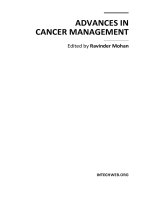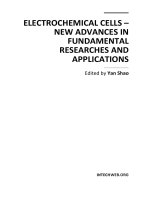advances in cancer research
Bạn đang xem bản rút gọn của tài liệu. Xem và tải ngay bản đầy đủ của tài liệu tại đây (15.12 MB, 277 trang )
ADVANCES IN CANCER RESEARCH
VOLUME 46
Interferon Treatment of
Human Neoplasia
This Page Intentionally Left Blank
ADVANCES IN
CANCER RESEARCH
Edited by
GEORGE KLEIN
SIDNEY WEINHOUSE
Department of Tumor Biology
Karolinska lnstitutet
Stockholm, Sweden
Fels Research Institute
Temple University Medical School
Philadelphia, Pennsylvania
Volume 46
Interferon Treatment of
Human Neoplasia
By HANS STRANDER
Radiumhemmet
Karolinska Hospital
S-104 01 Stockholm 60, Sweden
1986
ACADEMIC PRESS, INC.
Harcourt Brace Jovanovich, Publishers
Orlando San Diego New York Austin
London Montreal Sydney Tokyo Toronto
COPYRIGHT @ 1986 BY ACADEMIC
PRESS. INC
ALL RIGHTS RESERVED.
NO PART OF THIS PUBLICATION MAY BE REPRODUCED OR
TRANSMITTED IN ANY FORM OR BY ANY MEANS, ELECTRONIC
OR MECHANICAL. INCLUDING PHOTOCOPY. RECORDING, OR
ANY INFORMATION STORAGE AND RETRIEVAL SYSTEM. WITHOUT
PERMISSION IN WRITING FROM THE PUBLISHER.
ACADEMIC PRESS, INC.
Orlando. Florida 321187
United Kingdom Edition published by
ACADEMIC PRESS INC. ( L O N D O N ) LTD.
24-28 Oval Road. London NWI 7DX
LIBRARY
OF CONGRESS CATALOG CARD N U M B E R 52-13360
:
ISBN 0-12-006646-7
PRINTCD IN THE UNlTtD STATkS (IF AMtHlCA
Hh 87 88 89
Y X 7 h S J l ? l
CONTENTS
PREFACE........................................
.....................
ix
Chapter 1. Interferons (IFNs)
I . Introduction ..................................................
I1. Types .......................................................
111. Production and Purification .....................................
IV . Induction and Production Control ...............................
V . Genetics .....................................................
Chapter 2 . General Action
I . Action on Cells in General .....................................
I1 . Action on the Cell Surface ......................................
111. Tumor Viruses and Oncogenes ..................................
IV. Biological Response Modifiers ..................................
V . IFNs and Prostaglandins .......................................
10
15
16
18
19
Chapter 3. Anti-Growth Effects
I . The Anti-Growth Concept ......................................
I1 . Anti-Growth Effects in Tissue Culture ............................
111. Colony Techniques............................................
IV. Theory behind the Anti-Growth Concept .........................
V . Nude Mouse Experiments ......................................
20
21
28
30
32
Chapter 4 . Effects on the Immune System
I. General Effects ...............................................
I1. IFNs and NK Cells ............................................
.
.
111 Other Effector Systems ........................................
IV Immunoregulatory Circuits .....................................
V
36
44
54
55
vi
CONTENTS
Chapter 5 . Effects on Other Parameters
I . Receptors and Somatic Antigens . . . . . . . . . . . . . . . . . . . . . . . . . . . . . . . . .
I1. Tumor Cell Antigens and Other Markers ..........................
111. Various Laboratory Parameters ..................................
58
60
61
Chapter 6 . Pharmacology and Toxicity
I . IFN Effects in Animals-General Implications ....................
I1. Animal Toxici ty ...............................................
111. IFN Titrations and Pharmacokinetics .............................
IV . Anti-IFN Antibodies. ..........................................
V. Side Effects and Toxicity . . . . . . . . . . . . . . . . . . . . . . . . . . . . . . . . . . . . . . .
VI . IFN and Disease . . . . . . . . . . . . . . . . . . . . . . . . . . . . . . . . . . . . . . . . . . . . . .
66
67
68
71
72
81
Chapter 7. Animal Tumor Models
Text
........................................................
88
Chapter 8. Treatment of Human Papillomavirus-Associated Tumors
I . Local Treatment of Human Papillomavirus-AssociatedTumors
.......
I1. IFN Treatment of Juvenile Laryngeal Papillomatosis . . . . . . . . . . . . . . .
I11. Systemic IFN Treatment of Other HPV-Associated Tumors . . . . . . . . . .
99
102
106
Chapter 9. Regional Treatment of Other Tumors
I.
I1.
I11.
IV .
V.
VI .
VII .
VIII .
IX .
Intra- and Peritumoral IFN Therapy .............................
Local Treatment of Malignant Melanoma .........................
Local Treatment of Breast Cancer ...............................
Local Treatment of Cancer of the Uterine Cervix . . . . . . . . . . . . . . . . . . .
Local Treatment of Neurological Tumors . . . . . . . . . . . . . . . . . . . . . . . . .
Local Treatment of Head and Neck Tumors .......................
Local Treatment of Lung Tumors ................................
Local Treatment of Bladder Tumors ..............................
Intraarterial IFN Therapy ......................................
108
109
112
112
113
115
116
117
118
Chapter 10. Systemic Therapy of Indignant Disease
I.
I1.
I11.
IV.
V.
VI .
Systemic IFN Therapy of Tumors-Screening Trials . . . . . . . . . . . . . . .
Systemic Treatment of Leukemias ...............................
Systemic Treatment of Lymphomas., ............................
Systemic Treatment of Myelomatosis .............................
Systemic Treatment of Kaposi's Sarcoma ..........................
Systemic Treatment of Soft Tissue Sarcomas ......................
119
134
141
146
149
152
vi i
CONTENTS
VII . Systemic Treatment of Osteosarcomas ............................
VIII . Systemic Treatment of Malignant Melanoma ......................
IX. Systemic Treatment of Renal Cell Carcinoma ......................
X . Systemic Treatment of Lung Cancer .............................
XI. Systemic Treatment of Gastric Cancer ............................
XI1. Systemic Treatment of Colorectal Carcinoma ......................
XI11. Systemic and Intraarterial IFN Treatment of Liver Cancer . . . . . . . . . . .
XIV . Systemic Treatment of Carcinoids ...............................
xv. Systemic Treatment of Nasopharyngeal Carcinoma . . . . . . . . . . . . . . . . .
XVI . Systemic Treatment of Brain Tumors .............................
XVII . Systemic Treatment of Neuroblastoma ............................
XVIII . Systemic Treatment of Prostate Carcinoma ........................
XIX. Systemic Treatment of Carcinoma of the Uterine Cervix . . . . . . . . . . . . .
Systemic Treatment of Ovarian Carcinoma ........................
XXI . Systemic Treatment of Breast Cancer.............................
xx.
152
156
160
167
170
170
172
172
173
173
177
178
178
179
180
Chapter 11. Inducers
Text
........................................................
183
Chapter 12. Other Forms of IFN Therapy
I . IFN as an Antiviral Agent in Tumor Patients
......................
I1. Additional Uses of IFN Therapy .................................
185
189
Chapter 13. Conclusions
I . General Discussion and Future Prospects .........................
I1. Addendum ...................................................
191
202
BIBLI~C~L~PHY
..............................................................
204
INDEX ...............................................................
257
This Page Intentionally Left Blank
PREFACE
Information concerning the effects of interferons (IFNs) in the
treatment of tumors-especially
at the clinical level-has
been
compiled and presented in this volume. A rather complete survey is
included of what has happened in just a few years of intensive
international I F N research in this area. Since so many data have
accumulated from both experimental and clinical oncology sources,
references to information gathered before 1979 will be limited.
Included are data presented at symposia and references that are
difficult to obtain from general sources. The volume is almost entirely
devoted to data on humans, but some mention is made of animal
experimentation.
The book contains chapters dealing with experimental I F N effects,
with special emphasis on the types of IFNs and their actions that
cause regression of tumors. The volume starts with a survey of the
various IFNs, how they are produced, and how they act. Their
pharmacology and toxicity are discussed. A short chapter on animal
tumor models used for possible application to human tumor disease
follows. The book then deals with the treatment of benign tumor
diseases. I F N treatment of malignant diseases is also discussed. I F N
inducers and other forms of I F N therapy are mentioned. Concluding
the volume is a chapter summarizing the present situation and
suggestions for future research.
Readers most likely to find this book of particular interest will be
investigators actively involved in I F N effects and the possible
mechanisms underlying the effects achieved with human tumors.
This book will also be of interest to oncologists and other specialists
working with I F N at the clinical level. It should also fulfill the needs
of investigators interested in a broad introduction to the area. It is
clear that IFNs have become a permanent part of the armamentarium
used in the treatment of tumor disease in man and thus should be of
general interest to all engaged in clinical oncological research.
This work was made possible by grants from the Swedish Cancer
Association, The Cancer Society of Stockholm, The Albert and Mary
Lasker Foundation, and the Karolinska Hospital. I want to thank
ix
X
PREFACE
several people for help and advice: Kari Cantell, Ann-Charlott
Dahlstrom, Stefan Einhorn, Eva Gripenholm, Amy Klion, Edward
Rye, and Gerd Stridh. I am also indebted to the investigators who
kindly submitted unpublished results and manuscripts.
HANSSTRANUEH
CHAPTER 1
INTERFERONS (IFNs)
“The writing of an article helps to make the writer better informed on the subject he
discusses.”
Morris Fishbein (1938)
I. Introduction
Interferons (IFNs) are proteins or glycoproteins able to exert antiviral activity through their effects on the intracellular events of the viral
cycle. They belong to the family of biological response modifiers and
are constituents of the body’s defense system. IFNs were first defined
in 1957 (Isaacs and Lindenmann), although the phenomenon of viral
interference had been reported much earlier (for a review, see Nagano, 1975).Three classes of IFNs have since been described, but it is
quite possible that new types of IFNs will be discovered in connection with biological studies (see Van Damme et al., 1981).
IFNs can be induced in an organism by (1) virus infection, (2) a
variety of nonviral inducers, (3)mitogens, (4) antigens, and ( 5 ) tumor
cells. Since IFNs are produced under such varied circumstances, the
exact role played by these molecules in connection with various disease states must be deciphered. In addition, one would wish to understand their relevance to resistance to disease (Wilkinson and Morris,
198313).
Isaacs is said to have been in 1962 the first to consider large-scale
production of IFN. In the 1960s and early 1970s, the various factors
associated with such large-scale production were examined, particularly in Canada, Finland, France, the Soviet Union, the United States,
and Yugoslavia. In 1961, Gresser reported that IFNs could be produced in substantial amounts by human leukocytes.
This system was then studied in Finland, leading to the initial production of semipurified human leukocyte IFN-a (see Cantell et d.,
1981). Such IFNs were used during the 1970s on both viral and tumor
diseases. Subsequently, this type of natural IFN-a has been used in
other types of disease (cf. Merigan et al., 1982; Strander, 1983a, 1984).
It soon became evident that natural IFN-a could cause side effects in
the form of headache, malaise, and fever (Strander et al., 1973). Later
1
ADVANCES IN CANCER RESEARCH, VOL. 46
Copyright 0 1986 by Academic Press, Inc.
All rights of reproduction in any form reserved.
2
1.
INTERFERONS
(IFNS)
studies showed that even pure preparations caused similar side effects (Scott et al., 1981).
The results of IFN-a treatment of a variety of tumors were summarized in a report by a World Health Organization (WHO) Scientific
Group in 1982. Since that time, promising results have been obtained
in renal cell carcinoma, chronic myelogenous leukemia (CML), hairy
cell leukemia, Kaposi’s sarcoma, and several other diseases. Among
the most exciting effects were the ones on the various papillomavirusassociated diseases (juvenile laryngeal papillomatosis, common warts,
and condyloma acuminata).
Natural IFN-P was first produced in large amounts in 1972-1973
and has since been used on a variety of tumor patients, especially in
Western Europe and Japan. The large-scale production and use of
IFN-y has just begun.
An excellent review of the anti-tumor activities and pharmacokinetics of IFN, as well as a summary of the results of IFN treatment
of tumors in humans, was written by Stewart (1979a). Several more
recent reviews are listed in the Addendum to Chapter 13, before the
bibliography. The aim of the present review is to provide summaries
of the rationale for IFN use in the treatment of human neoplasia and of
the results obtained in this area to date.
II. Types
Interferons (IFNs) have been divided into three classes: a,p, and y
(cf. Collins, 1983a; Pestka and Baron, 1981; Pestka, 1983b; Pestka et
al., 1984).A fourth class, IFN-p, has been suggested by Wilkinson and
They found a substance with the essential characterisMorris (1983~).
tics of a classical IFN but with antiviral activity expressed only in
trisomy 21 human fibroblasts.
The IFN-a family contains many types of molecules, and it has been
suggested that up to 40 subtypes may ultimately be found (J. Collins,
personal communication). Several IFN-a subtypes have also been described in the murine system (Shaw et al., 1983). The reason for this
heterogeneity is unknown. Whether there are multiple subtypes of
IFN-p and IFN-y remains a matter of controversy (Collins, 1983b).
For a description of the old and new IFN nomenclatures, see Anonymous (1980). The main types of IFN used in clinical trials are listed in
Table I.
It took quite some time before IFNs were purified to homogeneity
(cf. Knight, 1978; Knight et al., 1981; Rubinstein, 1982a). The use of
monoclonal antibodies (see Milstein, 1982) has been extremely im-
TABLE I
USEDFOR CLINICAL
TRIALS
IFN PREPARATIONS
IFN
class
Subtypes
Number of
subtypes
Natural
a
various
15-40
Recombinant
a
a2
1
Impure, semipurified
or purified
Purified
Recombinant
a
A
1
Purified
Recombinant
a
D or a1
1
Purified
Lymphoblastoid
a
Several
5-8
Natural
8
One (?)
1
Semipurified
to purified
Semipurified
Recombinant
Recombinant
Natural
B
B
Recombinant
Y
1
Purified
Purified
Impure or
semipurified
Purified
Name
Y
Y1
Purity
Comment
More impure in earlier trials
Produced in E. coli; arginine at position 23;
deletion at position 44
Produced in E. coli; lysine at position 23;
deletion at position 44
Produced in E. coli; 29 amino acid variations from aA
From cultured lymphoma cells in oitro
or in hamsters
Can be purified; made from fibroblasts or
SV40-transformed cells
Cysteine at position 17
Serine at position 17
More impure in earlier trials
Probably different from natural y
4
1.
INTERFERONS
(IFNS)
portant in this respect. Recombinant DNA technology has also had
enormous impact on IFN research (Wetzel, 1980; Weissmann et al.,
1982a; Fiers et al., 1982).
Goeddel et al. (1980a) reported that human leukocyte IFN-a produced by Escherichia coli was biologically active, since it could protect squirrel monkeys from lethal encephalomyocarditis (EMC) infection. By 1981, the structures of eight different cloned human
leukocyte IFN-a cDNAs had been described (Goeddel et al., 1981).
Many distinct IFN-a sequences have since been determined, although this is just the beginning of an extensive research area (Weissmann et al., 1982b). The properties of the genetically engineered
IFN-a2 preparation have been reviewed (Nagabhushan et al., 1984).
Analogues or hybrids of human IFN-a have also been prepared, but
the clinical potential of such molecules remains to be seen (cf. Lee et
al., 1982a; Alton et al., 1983). So far, it has not been possible to find
active IFN fragments (Wetzel et al., 1982). Human IFN-P was cloned
in 1979 b y Taniguchi and collaborators (Goeddel et ul., 1980b; Taniguchi et al., 1982). Recombinant human IFN-y followed in 1982 (cf.
Gray et al., 1982; Rinderknecht, 1984).
Human lymphoblastoid IFN may be produced by exposing lymphoma cells to a viral inducer. It seems to consist of several primary
IFNs, the exact structures of which are unknown. There appears, however, to be little, if any, glycose present in these molecules (Allen and
Fantes, 1980).IFN-P is produced at the same time.
The biochemical properties and structures of the various human
IFNs have been reviewed (Hayes, 1981; Rubinstein, 1982b; Vilkek,
1982b). For a discussion of the evolution of the IFN molecules in
humans, see De Grado et al. (1982). These authors have proposed a
common ancestor for both virus-induced IFNs and IFN-y.
111. Production and Purification
An important contribution to IFN research was made by Gresser
(1961)when he demonstrated that peripheral leukocytes are able to
produce substantial amounts of IFN. The use of human leukocytes for
this purpose is in keeping with the modern concept of multiple uses of
donor blood (Hogman, 1979). During the 1960s, a substantial amount
of work was done in Cantell’s laboratory on the production of large
amounts of human IFN-a by suspended leukocytes (see Strander,
1971).This culminated in the production of stable, semipurified preparations useful for clinical trials in the early 1970s (Mogensen and
Cantell, 1977; Cantell and Hirvonen, 1978).For a more recent discus-
PRODUCTION AND PURIFICATION
5
sion of the preparation of human natural IFN-a, see Horowitz and
Horowitz (1984). Monocytes seem to be the main producers of IFN-a
in leukocyte preparations following Sendai virus induction (Saksela et
al., 1984).
Natural IFN-a preparations have limitations, however. Schoub et
al. (1983) found differences among individual preparations and
stressed the importance of doing comparative studies on the various
batches before their use in clinical trials. Others have criticized the
use of human leukocyte cultures for the production of IFN because of
the possibility of slow virus contamination of semipurified preparations (Wadell, 1977). Such a problem is illustrated by the acquired
immunodeficiency syndrome (AIDS). Of 2952 cases reported to date,
31 cases under investigation b y the Centers for Disease Control
(CDC) in the United States have no identified risk factors other than
having received blood transfusions within the 5 years preceding the
diagnosis (see Curran et al., 1984). Observations made on infants with
AIDS suggest transplacental, perinatal, or postnatal transmission of an
as yet unidentified infectious agent (see Scott et al., 1984). Taking into
consideration the seriousness of the neoplastic diseases being treated
by IFNs, the risks involved are, in my opinion, not strong enough to
prevent the use of natural IFN preparations. Furthermore, human
leukocyte IFN-a has been given to thousands of patients, and none of
them has developed AIDS so far.
Many tumor cells, including human lymphoma cells, spontaneously
produce IFN (Adams et al., 1975b). Twenty-one different human lymphoblastoid cell lines were screened for ability to produce IFN following exposure to Sendai virus (Strander et d . ,1975). One cell line,
which showed a good response, the Namalwa cell line, has since been
used for the large-scale production of human lymphoblastoid IFN-a,
especially in England, Japan, and Austria. Imanishi et al. (1982) have
used human lymphoblastoid cells grown in hamsters for this purpose.
For a discussion of the preparation of lymphoblastoid IFN, see Fantes
and Finter (1984).
Horoszewicz et al. (1978~)found that the best IFN-/3 producing
strain of human diploid foreskin fibroblasts had a translocation between chromosomes 5 and 15, although normal fibroblasts are also
generally good IFN-p producers. For a discussion of the production
and purification of natural human IFN-/3, see Billiau et al. (1979c),
Leong and Horoszewicz (1981), Van Damme and Billiau (l981), and
O’Malley et al. (1984).
Human natural IFN-y was developed for clinical use in several
laboratories around 1980 (cf. Papermaster and Baron, 1981-1982;
6
1.
INTERFERONS
(IFNS)
Johnson et al., 1981; DeLey et al., 1981, 1982). Other groups have
initiated such production (Braude, 1983b; K. Cantell and M. L. Kauppinen, personal communication). In some of these studies, diterpene
esters have been used as inducers of IFN-y (see Yip et al., 1981).
Purification of human natural IFN-y has been described b y Braude
( 19834.
Le et al. (1982) found a cloned human cutaneous lymphoma cell
line with a helper T cell phenotype which can be induced to produce
approximately equal amounts of IFN-a and IFN-y. Unfortunately, this
preparation cannot be given to patients because of the use of a phorbol
ester for the induction.
An important contribution to the area of production and purification
of IFNs was the development of a monoclonal antibody to human
leukocyte IFN-a (Secher and Burke, 1980). Originally described b y
Kohler and Milstein (1975), the establishment and screening of hybrids producing monoclonal antibodies have been developed to near
perfection (Morser et ul., 1981; Staehelin et al., 1981a,b).For a review
of recent techniques for the production of monoclonal antibodies, see
St. Groth and Scheidegger (1980) and Berd et al. (1982). Using these
improved techniques, mouse hybrids secreting monoclonal antibodies to human IFN-/3 (Hochkeppel et al., 1982)and IFN-y (Hochkeppel
and De Ley, 1982) were soon developed.
Lymphocytes also produce other substances with lymphotoxin activity (Granger et al., 1978) which may play a role in the IFN system.
Biotechnical laboratories are currently involved in the study of these
and other lymphokines for their possible clinical application (see
Fiers et al., 1983). IFN can be produced on a large scale by bacteria
(cf. Pestka, 1983a; Kingsman and Kingsman, 1983).It must be remembered, however, that it has not been determined whether the products
obtained from the various recombinant systems are equal in potency
to the natural products.
Several different recombinant IFN hybrids have been produced for
clinical trials (see Stebbing, 1983a). Perhaps the most important aspect of these hybrids, however, is that they will extend our understanding of the structural importance of the various parts of the IFN
molecules and will be helpful for the design of more effective compounds for clinical use. New IFNs can be formed by recombining the
DNAs that code for the different IFN subtypes. The clinical significance of these substances is unknown, although they have been
shown to be biologically active in some tissue culture systems (see
De la Maza et al., 1982).
INDUCTION AND PRODUCTION CONTROL
7
There are three recombinant IFN-a preparations currently in clinical use: ( ~ 2which
,
has an arginine residue substituted at position 23
and a deletion at position 44; aA, which has a lysine at position 23 and
a deletion at position 44; and aD, which differs from a A at 29 sites.
IFN-/3 and IFN-y present special problems because of the presence
of glycosylation. For example, although glycosylation is not a prerequisite for the various biological activities exerted by IFN-y in uitro
(see Doyle et al., 1982), it will be necessary to compare glycosylated
and nonglycosylated IFN-y preparations in clinical studies.
The common recombinant IFN-/3 has a cysteine residue at position
17. A variant, y-Ser, modified by the substitution of a serine residue at
this position, has increased stability (see Khosrovi, 1984). It has, in
addition, been shown to have antiviral, antiproliferative, and natural
killer (NK) cell activation properties similar to the parent molecule.
IFN-y has also been produced using recombinant technology. For a
review of the molecular cloning of human IFN-y cDNA and its expression in eukaryotic cells, see Devos et al. (1982). There are no known
differences among recombinant IFN-y preparations (see Borden et al.,
1984d). Vildek’s group recently demonstrated, however, that natural
IFN-y can be separated from the recombinant IFN-y produced in E.
coli by monoclonal antibodies. This may be due to a conformational
difference at least neat the active regions of these molecules (Le et al.,
1984). If this is the case, the current method of recombinant IFN-y
production will need to be reassessed and perhaps other host cells
considered. In this regard, it is worth noting that human IFN-y has
been expressed in cultured monkey cells (Gray et al., 1982).
In view of the multitude of methods of production and purification,
the quantitation of I F N preparations used in clinical trials is extremely important. Hence, standardized biological assays have been
developed (Myers, 1984). International units (IU), defined by these
assays, are used to express the concentrations of different IFN preparations. Monoclonal antibodies have also proved useful in the rapid
quantitation of IFNs (see Staehelin et al., 1981~).
A discussion of
points to consider in the production and testing of IFN for human use
may be found in Liu et al. (1984). The suggestions put forward on the
basis of this discussion should be followed up.
IV. Induction and Production Control
Different types of IFNs can be produced both as single products
and as mixtures in varying proportions. The production is dependent
8
1. INTERFERONS (IFNS)
on the cells used as well as the inducer. For a list of the various IFN
inducers, see Torrence and De Clercq (1981).Interferon induction b y
viruses is an extremely complex process (see Marcus, 1982), the regulation of which is not yet well understood at present. Control systems
are known to exist, however, at three levels: (1)at the level where the
IFN genes are accessible for transcription, (2) at the transcriptional
and posttranscriptional levels, and (3) at the translational level (see
Burke, 1982,1983). For a review of the posttranscriptional and translational control of gene expression in eukaryotes in general, see Revel
and Groner (1978).
Over 20 years have passed since Wheelock first identified IFN-y
(1965).Since that time, production of IFN-a, -/3, and -y has been denionstrated in various cell types. Human bone marrow stromal cells can
produce high levels of IFN-/3 (Shah et nl., 1983), although low levels
of IFN-a are probably produced as well. T cell lines also preferentially produce IFN-/3 (Matsuyama et al., 1982). Cyclosporine A inhibits the synthesis of IFN-y (Reem et al., 1982). Using a reverse
hemolytic plaque assay, Palacios et al. (1983) showed that human
IFN-.)I is produced by OKT3+,4+, 8-, HLA-DR T lymphocytes. When
human peripheral monocytes were exposed to killed bacteria, a subtype of IFN-a was initially induced. After 2-3 days, an IFN resembling IFN-y was detected and, finally, an atypical IFN-a, sensitive to
p H 2 treatment, appeared (Ronnblom et al., 1983b). Some bacteria
stimulated the T lymphocytes to produce IFN-y-like molecules. The
IFN-a was produced by nonadherent, predominantly Fc receptorbearing, non-T, non-B cells. It would, on the basis of these results, be
interesting to try to mimic some of the production sequences observed
in uitro for the in uiuo treatment of infections or neoplasms in experimental animals. For a discussion of the cellular modulation of IFN
induction by polyribonucleotides, see Borden (1981-1982).
V. Genetics
The genetics of the IFN system have been reviewed by many authors (Stewart, 1979a; Slate and Ruddle, 1979; Seghal, 1982a,b; Epstein and Epstein, 1981-1982, 1983). In the mouse, all of the IFN
genes are located on chromosome 4 (Lovett et al., 1984). It will be
interesting to see how the various IFN genes map in other mammalian
cells (see Slate and Ruddle, 1981). Some data are already available
(see D’Eustachio and Ruddle, 1983).
GENETICS
9
In 1982, C. J. Epstein et al. (1982) concluded that the gene product
of the human chromosome 21 locus IFRC (a specific cell surface
receptor for IFN-a) was the real IFN-a receptor. Chromosome 21
also controls the antiviral response to IFN-y (Epstein et al., 1981)
and contains the gene coding for the IFN-y receptor (Weil et al.,
1983b).
CHAPTER 2
GENERAL ACTION
1. Action on Cells in General
The biochemical effects of IFN on cells have been studied extensively over the past years (cf. Lengyel, 1982; Williams, 1983). IFN
action is a complex process involving a multiplicity of substances and
molecular mechanisms (cf. Hovanessian, 1979; Lengyel, 1981).
Heron and Berg (1978) studied the effects of temperature on IFN
action. They found three effects of natural human IFN-a to be temperature dependent; namely, the development of the antiviral state, augmentation of the generation of NK cells, and growth inhibition. Cellmediated 1ympholysis and the mixed lymphocyte reaction peaked at
38-39°C. The anti-growth effects increased with rising temperature.
These findings challenge the use of antipyretics during IFN therapy.
The biochemistry of the IFN-induced antiviral state was reviewed
by Revel (1979) and more recently by McMahon and Kerr (1983).The
state seems to be controlled by several components. Clinically, the
most important of these is (2’-5’)A synthetase (cf. Williams and Kerr,
1980; Dougherty et al., 1981-1982), because it can be used as a
marker of IFN action on heterologous cells; for example, on human
tumors xenografted onto nude mice (Cayley et al., 1982). It is not
known how important this system is in comparison to an induced
protein kinase and other affected pathways in the cell. The kinase is
also likely to play a role, however, since the same conditions that
activate the (2’-5’)A system trigger the kinase. Munoz et al. (1983)
suggested that under some circumstances degradation of cellular RNA
upon virus infection does not take place in IFN-treated cells. The
important point at the moment, in my opinion, is that all of these
pathways, starting with an interaction between IFN and the cell membrane and leading to the antiviral state, have begun to unravel.
IFNs often exert their most intense effects on homologous cells (see
Gillespie and Carter, 1981-1982). Types of homologous cells, however, may respond differently to various IFNs. Several proteins are
induced in IFN-exposed cells (see, for example, Sundstrom and
Lundgren, 1983), and it will be interesting to follow the cloning of
cDNA segments complementary to the corresponding mRNAs (see
Lengyel et al., 1982). Extremely small differences in polypeptide pat10
ACTION ON CELLS IN GENERAL
11
terns were detected when the proteins induced by pure recombinant
IFN-a and partially purified natural human IFN-y were compared
(Weil et al., 1983a, 1983-1984). Furthermore, it has been shown in
both normal and malignant cell lines and in freshly isolated human
tumor cells that recombinant IFN-y induces the same peptides as
recombinant IFN-a, as well as several additional ones that vary among
cell types (Epstein et al., 1983). The implications for this in terms of
IFN therapy is unknown.
The antiviral assay of IFNs has been well standardized (see Finter,
1981).Stebbing and May (1982) compared various natural and recombinant IFN-a, -p, and -7 in such an assay employing vesicular stomatitis virus (VSV). They could not detect any significant differences
in pairwise comparisons using the various IFNs. The time schedule
for optimal action of IFN-a and IFN-p in uivo might differ considerably from what would be optimal for IFN-y (Dianzani et al., 1978). It
has been found by De Somer’s group that purified IFN-y is able both
to inhibit the growth of lyniphoblastoid cells and to potentiate NK cell
activity of fresh donor lymphocytes, although in neither case was it
more active than IFN-a or IFN-/3 of similar antiviral potency (De Ley
et al., 1980).
As previously mentioned, hybrids between different leukocyte
IFN-a subtypes have already been produced, and some of them have
been tested in the laboratory for various properties (see, for example,
Pestka et al., 1982a). It is not known which, if any, of these different
hybrids will have clinical relevance. In addition, it is possible that
many of them will prove to be antigenic when tested in uiuo.
IFN sensitivity and inducibility are firmly connected with the differentiation process (Burke et al., 1978). It has been suggested that
IFNs may inhibit the differential gene expression involved in eukaryotic cell differentiation (Grossberg et al., 1981). It has, in fact, been
clearly established that IFNs can exert selective effects on the expression of some genes involved in differentiation (Lotem and Sachs,
1978).Work with IFN-resistant clones of Friend leukemia cells seems
to indicate that the antiviral and differentiation effects of IFN act
through different mechanisms (Affabris et al., 1982). For an interesting general discussion of the differentiation problem and phenotypic
reversal of myeloid leukemic cells, see Sachs (1978).
Tomida et al. (1980) found that IFN could enhance the differentiation of mouse myeloid leukemic cells. IFN did not itself induce the
differentiation, but it did augment induction by several other substances. IFN could, however, induce lysozyme activity in these cells
and behaved in a synergistic manner with other inducers in this re-
12
2.
GENERAL ACTION
spect. It is interesting that the induction of differentiation in this system can also be achieved with hormone preparations. Tomida et al.
further demonstrated in 1982 that IFN-a and IFN-/3 could enhance
the induction of differentiation of promyelocytic leukemia cells in
humans. The potential of such systems in tumor therapy is, as yet,
unexplored (see Tomida et aZ., 1983a), but will soon be investigated.
The role of I F N in normal myelopoiesis has not been firmly established. It will be interesting to see how IFN affects the differentiation
process in these cells that maintain an equilibrium between proliferation and differentiation (Dayton et al., 1983).
In in uitro systems, where cells can be induced with various substances to produce hemoglobin, it can be shown that various human
IFNs can increase production at low doses, whereas high doses are
deleterious to hemoglobinization (Cioi! et al., 1983).This might be an
important observation affecting the construction of optimal clinical
schedules.
Verma et al. (1981) found that human leukocyte IFN-a can block
granulocytic differentiation. In suspension cultures, an accumulation
of granulocyte-macrophage progenitor cells, cluster-forming cells,
and morphologically identifiable myeloid precursors was seen with
IFN-a treatment. Human placental conditioned medium, used as a
source of colony-stimulating factor, could effectively counteract this
effect. Therefore, the authors suggested that natural human leukocyte
IFN-a might play a regulatory role in the control of normal granulopoietic proliferation and differentiation. Trinchieri’s group made the
important discovery that IFN-y, but not IFN-a or IFN-P, induces
monocytic differentiation in myeloid cells (Perussia et nl., 1983a).
Immature myeloid cells from normal bone marrow or from the blood
of patients with CML can be made to differentiate into monocyte-like
cells by IFN-y. Even myeloid cells as mature as metamyelocytes can
be induced to undergo monocytic differentiation. This could be an
important function of human IFN-y and has direct bearing on the
treatment of various human tumors with IFN-y preparations. Model
systems have been developed in uitro to study IFN-a and IFN-y together with inducers of differentiation in order to work out a strategy
for IFN therapy directed at leukemic cell differentiation (Hamburger
et al., 1983).
It has been shown that human amniotic fluid contains IFN activity
(cf. Chany et d.,1983; Tan and Inoue, 1982). The role pli1yed by these
IFNs, however, remains unclear. They could play a role during embryonic development, by protecting the cells from virus infections or
contributing to the immune tolerance of the mother. It is of interest
ACTION ON CELLS IN GENERAL
13
that most pregnancies are also associated with elevated (2’-5’)A synthetase levels. This suggests that IFNs work actively in an immunoregulatory sense against viral invasion and the dissemination of disease (Williams et al., 1982).
Hattori et al. (1983) found that a human histiocytic lymphoma-derived cell line could be made to differentiate by exposure to IFN-P or
recombinant or natural IFN-a. In contrast, a promyelocytic leukemiaderived cell line that would differentiate toward cells of the monocyte
lineage in response to certain inducers did not differentiate when
cultured with IFN. Robert et al. (1984) studied the influence of semipurified natural human leukocyte IFN-(Uon differentiation of chronic
lymphocytic leukemia cells in vitro. Both proliferation and differentiation were induced in leukemic cells in two of six tested patients. In
two other patients, only differentiation was induced. Sonnenfeld et al.
(1983)found an interesting correlation between carcinogenic potential and the ability to inhibit IFN-a or IFN-P production.
The diversity of IFN actions has been emphasized every time clinical application is discussed (cf., for example, Gresser, 1977b; TaylorPapadimitriou and Balkwill, 1982). It has even been postulated that
the IFN response may play a role in the aging process (Bocci, 1980a).
It is known that IFNs cause a large increase in the amount of HLA
mRNA in exposed cells (Fellow et al., 1982). IFNs can also affect
phosphorylation of fibrinogen and other plasma proteins by affecting
platelet kinase activities (Hovanessian et al., 1983).
We know that IFNs can enhance several particular cell functions.
Exposure of cultured neurons to human natural IFN-a, for example,
causes enhanced excitability of the neurons (Calvet and Gresser,
1979). Tunicamycin, an inhibitor of glycosylation, can potentiate the
inhibitory effects of IFNs both on virus multiplication and on cell
growth (Maheshwari et al., 1983b). Renton and Mannering (1976a,b)
made the discovery that IFN-inducing agents could cause a depression of the hepatic cytochrome P-450-linked monooxygenase system
in rodents. They predicted that viral infections and treatment with
agents that induce IFN would impair the metabolism of drugs in humans (see Mannering et al., 1980). This is an important concept to
consider with regard to combination treatments, as the metabolism of
a variety of drugs might be changed when given simultaneously with
IFN. Reiners et al. (1984) have since shown that the levels of depression of promutagen activation correlate with cytochrome P-450 content and the induction of IFN-y. This suggests that some IFNs, for
example, IFN-y, may play an active role in the hepatic promutagen/
procarcinogen activation.
14
2.
GENERAL ACTION
It has been emphasized that the effects of IFNs not only have to
deal with what might happen in the host, but also with the changing
behavior of the tumor cell (Siegal et al., 1982). In the system employed by these investigators, it was found that different IFNs caused
increased type IV collagenase levels surrounding tumor cells leading
to increased invasiveness of Ewing’s sarcoma with IFN exposure.
It has been suggested that the anti-tumor efiects of IFN may be
related to their ability to modulate differentiation in tumor cells.
Rivihre and Hovanessian (1983)made the interesting observation that
tumor cells in organisms may themselves not only produce IFN but
may also respond to their own IFN. The practical implications of this
finding remain to be determined.
Sister chromatid exchanges do not seem to be affected by human
leukocyte IFN-a in peripheral blood lymphocytes from normal donors
(Viiayalaxmi, 1982). It has been suggested that IFN has antimutagenic
properties (Zasukhina, 1982) but that a fragile site on chromosome 16
can be induced by IFN or ethanol. This gap is considered to be a
normal chromosome variant, however (Hecht et al., 1981).Actually, in
animal systems, it has already been shown that IFN treatment can
prevent stable integration and expression of transfected plasmids containing cloned genes from hamster ovarian cells. In contrast, IFN does
not prevent the transient expression of one of these genes in its unintegrated form (Dubois et ul., 1983b).
Chany-Fournier (1983)has reviewed the evidence for loss of malignancy in transformed cells exposed to IFNs and, in particular, the
continuous treatment of Moloney sarcoma virus (MSV)-transformed
cells with IFN. These cells recover normal phenotype and contact
inhibition and lose the ability to form colonies in agar. This experimental model consisting of the polymerization of cytoskeleton and
new production of collagen and fibronectin emphasizes the role
played by this type of transformation in the anti-tumor spectrum of
IFN. Pfeffer and Tamm (1982)found that volume increase was a sensitive indicator of IFN effects on cellular phenotype. The phenotype
reversion of transformed cells that can be induced by IFNs has, in
fact, been associated with changes in the cell cytoskeleton (BroutyBoy6 et al., 1981). Clones of x-ray-transformed cells passaged in the
continuous presence of IFNs progressively acquire characteristics of a
nontransformed phenotype. This reversion induced in uitro by IFN
preparations has been observed in clones of transformed cells containing C-type virus particles as well as in virus-free clones (Brouty-Boy6
and Gresser, 1982).
IFN also causes a dose-dependent inhibition of ornithine decarbox-









